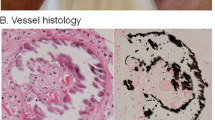Abstract
Blackfoot disease is an endemic disease of the peripheral vascular system reported more than fifty years ago in the southwest coast of Taiwan, Republic of China.1 The symptoms are similar to those of the Buerger’s disease or thromboangiitis obliterans.2 It is characterized pathologically by intravascular clot formation and inflammation of the vascular wall, which lead to partial or complete occlusion of the vessels involved.3 The area distributed by the diseased vessel then becomes discolored and gangrenous. The lesion often occurs on the lower extremities, hence the name Blackfoot disease.4 Other findings include pigmentation, atherosclerosis and a high level of high density lipoprotein (HDL), but a low level of low density lipoprotein (LDL).2,5 According to the statistics, 97% of Blackfoot disease patients will end up with either surgical amputation or natural disjointment due to gangrene.6 After almost thirty years of investigations, no specific treatment has been found. The primary cause of Blackfoot disease still remains elusive despite some intensive studies.7,8 Chen et al.9 reported that the artesian well water of endemic areas contained high concentrations of arsenic (0.1–0.35 ppm). Lu and Ling8 also found that ergotamine compounds were unusually high in level in the artesian well water. Both groups of investigators proposed that high concentrations of arsenic and ergotamine compounds in the drinking water in the endemic areas might be the main cause of Blackfoot disease. However, the installation of new water supply and drainage system since 1960 in the endemic areas has not eradicated or significantly reduced the incidence of the disease.10 In the present report, study of prostaglandins, particularly on 6-keto-PGF1α and thromboxane B2 (TXB2), the stable natural metabolic intermediates of prostacyclin (PGI2) and thromboxane A2 (TXA2) respectively, had been carried out among the patients. PGI2 is an important factor in platelet anti-aggregation and blood vessel dilatation, and plays an important role in the prevention of atherosclerosis and arterial thrombosis.11 TXA2 exerts opposite physiological effects of PGI2. The enzyme activities of prostacyclin synthase, the prime enzyme for the synthesis of PGI2, and 15-hydroxyprostaglandin dehydrogenase (15-OH-PGDH), the enzyme involved in the conversion of PGI2 to an inactive form 15-OH-PGI2, were also studied. The aim is to determine whether there is any change in PGI2 and TXA2 metabolism in Blackfoot disease patients.
Access this chapter
Tax calculation will be finalised at checkout
Purchases are for personal use only
Preview
Unable to display preview. Download preview PDF.
Similar content being viewed by others
References
S. Yeh and S.W. How, A pathological study on the Blackfoot disease in Taiwan. Reports, Institute of Pathology, Nat. Taiwan Univ., 14:25 (1963).
W.P. Tseng, Outcome of patients with blackfoot disease, J. Formosan Med. Asso., 74:37 (1975).
F.J. Lu, Study on fluorescent compounds in drinking water of endemic areas for Blackfoot disease and re-investigation of the causes of Blackfoot disease. National Science Council Monthly, 6:388 (1978).
K.P. Chen and H.Y. Wu, Epidemiologic studies on Blackfoot disease 2. A study of source of drinking water in relation to the disease, J. Formosan Med. Asso., 81:611 (1962).
F.L. Lee, Personal communication. Provincial Tainan Hospital, Taiwan, Republic of China (1985).
W.Y. Chen and E.P. Lien, Experimental studies on the drinking water of Blackfoot disease endemic areas 1. Studies on the changes of the limbs of experimental rats receiving repeated injections of drinking water of Blackfoot disease endemic area, J. Formosan Med. Asso., 62:794 (1963).
W.Y. Chen and W.P. Tseng, Experimental studies on the drinking water of Blackfoot disease endemic areas 3. Skin test with drinking water of Blackfoot disease endemic area, J. Formosan Med. Asso., 63:298 (1964).
F.J. Lu and K.H. Ling, Studies on fluorescent compounds in drinking water of Blackfoot diseaseendemic areas 6. A preliminary experimental study on peripheral vasculopathy, J. Formosan Med. Asso., 78:314 (1979).
K.P. Chen, H.Y. Wu and T.C. Wu, Epidemiologic studies on Blackfoot disease in Taiwan 3. Phy-siochemical characteristics of drinking water in endemic Blackfoot disease area. Memoirs Coll. Med. Nat. Taiwan Univ., 8:115 (1962).
O.T. Mak, S.J. Huang and S.H. Chen, Study of Blackfoot disease—sex, age, duration of disease, occupation and geographic distribution, J. Cheng Kung Univ. Sci., Eng. & Med. Section, 20:119 (1985).
U.S. Moncada, Biology and therapeutic potential of prostacyclin, Prog. Cerebrovascular Disease, 14:157 (1983).
O.T. Mak and S.H. Chen, Effects of two anti-depressant drugs—Imipramine and amitriptyline—on the enzyme activity of 15-hydroxyprostaglandin dehydrogenase purified from brain, lung, liver and kidney from mouse. Prog. Lipid Res., 25:153 (1986).
J.A. Salmon and R.J. Flower, Preparation and assay of prostacyclin synthase. Methods in Enzymol., 86:91 (1982).
G. Graff, Preparation of PGGj and PGH2, Methods in Enzymol., 86:376 (1982).
J.M. Bailey, Prostacyclins, thromboxanes and cardiovascular disease, TIBS, 4:68 (1979).
Y.C. Ko, A critical review of epidemiologic studies on Blackfoot disease, J. UOEH, 8:339–353 (1986).
O.T. Mak, S.H. Chen and M.H. Cheng, Effects of arsenate and ergot alkaloid compounds on prostacyclin synthesis in human umbilical endothelium. Cell Biol. Int. Rep., 10:287 (1986).
Author information
Authors and Affiliations
Editor information
Editors and Affiliations
Rights and permissions
Copyright information
© 1988 Plenum Press, New York
About this chapter
Cite this chapter
Mak, OT. (1988). Prostacyclin Production in Vascular Endothelium of Patients with Blackfoot Disease. In: Chien, S. (eds) Vascular Endothelium in Health and Disease. Advances in Experimental Medicine and Biology, vol 242. Springer, Boston, MA. https://doi.org/10.1007/978-1-4684-8935-4_14
Download citation
DOI: https://doi.org/10.1007/978-1-4684-8935-4_14
Publisher Name: Springer, Boston, MA
Print ISBN: 978-1-4684-8937-8
Online ISBN: 978-1-4684-8935-4
eBook Packages: Springer Book Archive




